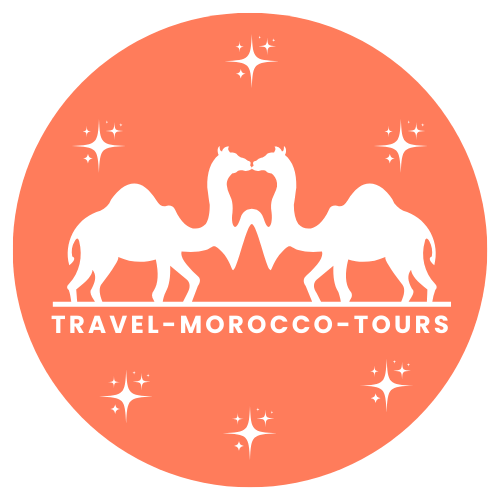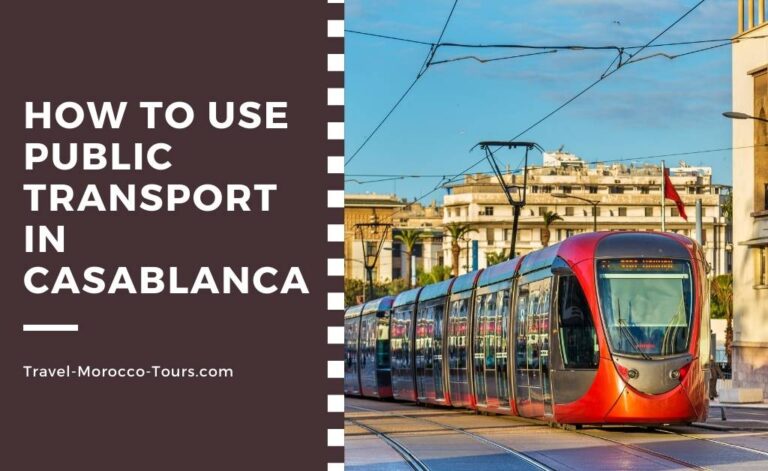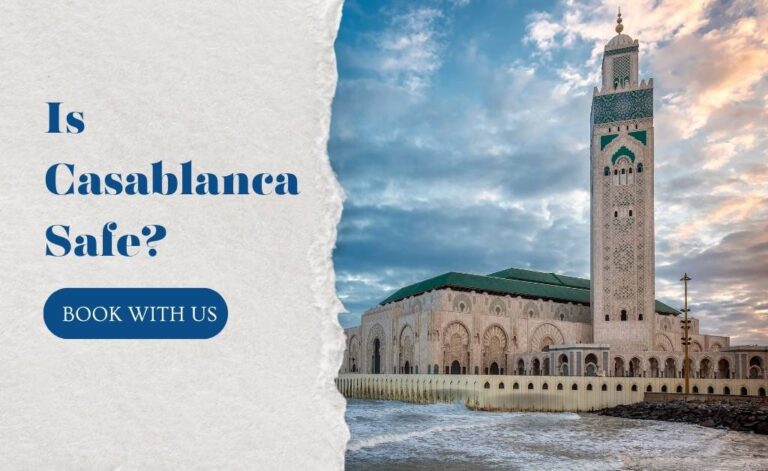Casablanca is a city full of energy, culture, and incredible food. While many visitors come for its stunning architecture and coastal views, the real magic is in its street food markets. These bustling markets are where locals gather to eat, socialize, and enjoy authentic Moroccan flavors.
From fresh seafood at Marché Central to the hidden food stalls in Derb Ghallef, the variety of street food is endless. Whether you’re craving grilled meats, traditional Moroccan pastries, or a hot bowl of harira soup, Casablanca has something for every foodie.
In this guide, we’ll take you through the best street food markets, must-try dishes, and hidden gems, giving you everything you need to enjoy an unforgettable food adventure.
Best Street Food Markets in Casablanca
Casablanca is home to several vibrant street food markets, each offering a unique food experience.
These markets are filled with the smell of sizzling meat, the sound of vendors calling out their best deals, and the sight of fresh ingredients being prepared right in front of you. Whether you’re exploring the historic central market or diving into the late-night food scene, each market has its own charm and specialties.
1. Marché Central
One of the most famous food markets in Casablanca is Marché Central, located right in the heart of the city. This market is a paradise for seafood lovers, offering a wide range of freshly caught fish, oysters, shrimp, and squid. Vendors display their seafood on large ice trays, allowing customers to pick what they want before having it grilled or fried on the spot.
The best way to enjoy Marché Central is to order a seafood platter that includes a mix of grilled sardines, fried calamari, and fresh oysters served with a slice of lemon.
Aside from seafood, you’ll also find juice stands selling freshly squeezed orange juice, pomegranate juice, and avocado smoothies. These drinks are a great way to cool down on a hot day while exploring the market.
There are also small bakeries that sell traditional Moroccan pastries like chebakia (sesame cookies soaked in honey) and msemen (flaky Moroccan pancakes served with honey or cheese). The market is lively from morning until late afternoon, making it the perfect place for a delicious lunch.
2. Habous Market
For those who want to experience a more traditional side of Moroccan street food, Habous Market is a must-visit. This market, also known as the “New Medina,” is famous for its old-world charm, artisan shops, and delicious food stalls.
Unlike Marché Central, which focuses on seafood, Habous Market is all about Moroccan baked goods and sweet treats. Here, you’ll find some of the best Moroccan pastries in the city, including:
- Chebakia – A flower-shaped pastry soaked in honey and sprinkled with sesame seeds
- Briouats – Small crispy pastries stuffed with almond paste or spiced meat
- Sellou – A sweet and nutty energy snack made from toasted flour, almonds, and sesame seeds
One of the highlights of visiting Habous is stopping by a traditional Moroccan bakery, where you can watch bakers prepare fresh khobz (Moroccan bread) in wood-fired ovens. Many locals visit these bakeries early in the morning to buy bread that they will eat throughout the day.
Another must-try is msemen, a flaky pancake often stuffed with spiced ground meat or served with honey. Pair it with a cup of hot mint tea, and you have the perfect Moroccan breakfast or snack.
3. Derb Ghallef
If you’re looking for cheap and delicious street food, Derb Ghallef is the place to be. This bustling market is mostly known for selling electronics and second-hand goods, but hidden among the shops are some of the best food stalls in Casablanca.
Unlike the more tourist-friendly Marché Central and Habous Market, Derb Ghallef is where many locals go for quick, affordable meals.
One of the most popular dishes here is the grilled merguez sandwich. Merguez is a spicy North African lamb sausage that is grilled over charcoal and served in a crusty baguette with harissa (a spicy chili paste) and onions.
Another local favorite is kefta brochettes, which are skewers of minced meat mixed with spices and grilled to perfection. The smoky aroma of grilled meat fills the air, making it impossible to resist stopping for a bite.
If you’re in the mood for something warm and comforting, try a bowl of harira soup. This tomato-based soup is made with lentils, chickpeas, and fresh herbs, making it both nutritious and full of flavor. Many vendors serve it with a side of fresh bread or dates, making it a perfect street food meal.
4. Maarif Night Market
If you’re hungry after dark, head to Maarif’s night market, one of the best places to experience Casablanca’s late-night food scene. This area comes alive at night with street food vendors selling Moroccan tacos, grilled meat skewers, and sweet treats.
One of the most popular dishes here is Moroccan tacos, a fusion dish that has become a favorite among young Moroccans. Unlike Mexican tacos, Moroccan tacos are made with a large tortilla stuffed with grilled meat, cheese, and French fries, then folded and toasted on a grill. The result is a crispy, cheesy, and satisfying street food snack.
For those with a sweet tooth, sfenj (Moroccan doughnuts) are a must-try. These fluffy, deep-fried dough rings are coated in sugar and served piping hot. Pair them with a cup of spiced Moroccan tea, and you have the perfect late-night treat.
Must-Try Street Foods in Casablanca
Aside from the food markets, there are certain dishes you simply cannot leave Casablanca without trying. These include:
1. Grilled Sardines
Grilled sardines are one of the most loved street foods in Casablanca. Freshly caught from the Atlantic, they are seasoned with salt, cumin, and lemon, then grilled over charcoal. Served with Moroccan bread and spicy harissa sauce, they are crispy on the outside and tender inside. You can find the best ones at Marché Central and food stalls near the port.
2. Bissara
Bissara is a thick, creamy fava bean soup that locals enjoy for breakfast. It is simple but full of flavor, made with blended beans, garlic, olive oil, and cumin. It is served hot with fresh bread and a drizzle of olive oil on top. The best places to try it are in small, family-run cafés or street food stalls in Habous Market.
3. Harira
Harira is a rich and hearty soup made with tomatoes, lentils, chickpeas, and fresh herbs. It is usually eaten with dates or chebakia (honey-coated cookies), especially during Ramadan. It has a warm, spiced flavor and is a great dish to enjoy in the evening. Many food markets and street vendors serve harira, especially in Maarif Night Market.
4. Snail Soup (Babbouche)
Babbouche is a spiced snail soup, loved by locals for its rich broth. The snails are cooked with anise, cinnamon, ginger, and cloves, creating a flavorful and slightly peppery taste. Many Moroccans believe it has health benefits, especially for digestion. You’ll find vendors selling it from big steaming pots in Derb Ghallef and old-town markets.
5. Brochettes
Brochettes are juicy meat skewers, grilled over charcoal and served with warm bread. They can be made with lamb, chicken, or beef, marinated in Moroccan spices like cumin, paprika, and garlic. Often served with grilled vegetables and spicy sauces, they are a must-try for meat lovers. The best brochettes can be found in street stalls at Derb Ghallef and Maarif Night Market.
6. Moroccan Pastries
Casablanca’s street food isn’t just about savory dishes, Moroccan pastries are just as popular. Some must-try sweets include:
- Chebakia: A sesame-coated, honey-soaked cookie, crunchy and sweet.
- Briouats: Flaky pastries filled with almonds or spiced meat.
- Sellou: A toasted flour and nut-based snack, packed with flavor.
Is street food safe to eat in Casablanca?
Most street food is safe if you follow a few tips:
1. Pick busy stalls: If locals are eating there, the food is likely fresh and safe.
2. Watch them cook: Choose stalls where food is cooked hot and served right away (like grilled meats or fried snacks).
3. Avoid raw veggies: Salads or uncooked herbs might be washed with tap water. Stick to cooked or peeled foods (like oranges or bananas).
4. Drink bottled water: Don’t use ice from street vendors unless it’s made with bottled water.
5. Bring hand sanitizer: Some stalls don’t have hand-washing stations.
Where is the best area for street food in Casablanca?
The Old Medina is the top spot for cheap, authentic street food. Wander through narrow streets and try stalls selling snail soup, fried fish, or fresh orange juice.
For seafood, head to the Corniche (the beachfront road in Aïn Diab). Here, vendors grill shrimp, calamari, and whole fish right by the ocean.
If you want a mix of food and shopping, visit Derb Ghallef (a busy market area with snacks like kebabs and sweets).
Are street food markets open at night?
Yes! Many street food areas come alive at night. The Corniche and Boulevard Mohammed V (a main city street) have stalls open until late, serving snacks like maakouda (potato fritters), grilled meats, and sweet pancakes.
In the Old Medina, some vendors stay open past midnight, especially on weekends. Nighttime is also great for trying mint tea or fresh sugarcane juice from carts.
How much does street food cost in Casablanca?
Street food is very affordable! For example:
- Snacks like msemen or maakouda: 5–10 MAD.
- A bowl of harira or bissara: 10–15 MAD.
- Grilled fish or meat skewers: 20–40 MAD.
- Seafood platter at the Corniche: 50–80 MAD.
Bring small bills and coins, as vendors rarely take credit cards.
Can I find vegetarian street food in Casablanca?
Yes! Many Moroccan dishes are vegetarian-friendly. Try:
1. Zaalouk: Smoky eggplant and tomato dip, served with bread.
2. Vegetable Tagine: Slow-cooked veggies like carrots, potatoes, and zucchini in spices.
3. Harcha: A buttery semolina bread, often eaten with jam or cheese.
4. Fruit carts: Stalls sell sliced melon, figs, or prickly pear (a local fruit).
Ask for “khobz” (bread) with olive oil and ask vendors to skip meat if unsure.
Do vendors speak English at the markets?
Some vendors in tourist areas speak basic English, but learning a few Arabic or French phrases helps:
- “Salam” = Hello
- “Shukran” = Thank you
- “Kam el harga?” = How much is this?
- “La lahm, min fadlik” = No meat, please.
Pointing and smiling works too! Vendors are used to tourists and will try to help.
What’s the best time to visit street food markets?
Go in the evening (6–10 PM) when the weather cools down and stalls are busiest. Mornings (8–11 AM) are good for breakfast foods like harsha (cornbread) or bissara.
Avoid midday heat (12–3 PM), as some vendors close. Fridays and weekends are livelier, but also more crowded.
Is Casablanca street food different from Marrakech?
Yes! Casablanca has more seafood (like grilled sardines) because it’s a coastal city. Marrakech is famous for snail soup and dried fruit stalls. Casablanca’s street food feels more “local” and less touristy, while Marrakech has bigger markets like Jemaa el-Fna with snake charmers and music. Both cities are great, but Casablanca is better for fresh fish and modern snacks like crepes or juice bars.
Faqs:
Does Casablanca have markets?
Yes! Casablanca has many markets for shopping. The most popular is Marché Central (Central Market), where locals sell fresh fish, fruits, and veggies, plus handmade crafts like pottery and jewelry.
Another spot is the Habous Quarter (New Medina), a calm, traditional market with arches and small shops. Here, you’ll find leather bags, spices, and traditional clothes like djellabas (long robes).
For modern shopping, visit Morocco Mall, it’s huge, with global brands, cafes, and even an aquarium! Street vendors also sell snacks and small items in busy areas.
What to buy from Casablanca?
Casablanca is great for buying unique Moroccan items. Look for soft leather goods like bags, belts, or babouches (colorful slippers), they’re cheap and high quality. Colorful pottery (like tagine pots) and metal lanterns with pretty designs are perfect for home decor.
Spices like saffron, cumin, or ras el hanout (a spice mix) are cheap and tasty for cooking. Argan oil is a must-buy use it on your skin, hair, or even in salads! Don’t forget handmade rugs or blankets with bright patterns.
For something special, try traditional Moroccan tea sets or silver jewelry.
Why is Casablanca famous for?
Casablanca is famous for three reasons. First, the movie Casablanca (a classic love story from 1942), though it wasn’t filmed here, the name makes people curious! Second, the Hassan II Mosque, one of the world’s largest mosques. It sits partly over the ocean and has a tall minaret (tower).
Third, it’s Morocco’s business and trade center, with skyscrapers, banks, and a busy port. The city also has a mix of old and new, like French colonial buildings, modern art deco areas, and the lively Corniche (beachfront with restaurants).
Is Casablanca good for shopping?
Yes! Casablanca is great for shopping if you like both modern and traditional styles. For modern shopping, visit Morocco Mall (with luxury brands and a Ferris wheel) or Anfa Place Mall.
For traditional items, go to Habous Quarter or Marché Central. Prices here are often cheaper than in touristy cities like Marrakech. But if you want giant old souks (markets) with endless crafts, Marrakech or Fes are better. Casablanca is perfect for a mix, buy Argan oil or spices here, then save bigger purchases (like rugs) for other cities!
Is Casablanca safe for tourists?
Yes, Casablanca is generally safe for travelers! Stick to well-lit areas at night, avoid flashing valuables, and use common sense in crowded spots. For detailed safety tips (like solo travel advice or scams to avoid), check out our full guide: Is Casablanca Safe?
What are the best things to do in Casablanca?
Don’t miss the Hassan II Mosque, the vibrant Medina, or sunset walks at Ain Diab Corniche! We’ve curated 30+ unique activities, hidden gems, and day trips in our ultimate guide: Things to Do in Casablanca
How do I use public transport in Casablanca?
Easy! The tram is the cheapest and fastest way to explore, grab a reloadable card at any station. For step-by-step tram/bus routes, ticket hacks, and taxi tips, read our local’s guide: Casablanca Public Transport Made Easy
Conclusion
Casablanca’s street food markets are a must-visit for any food lover. Whether you’re exploring the seafood stalls of Marché Central, enjoying traditional pastries in Habous, or grabbing a late-night snack in Maarif, every bite tells a story of Moroccan culture and history. Street food is more than just a meal, it’s an experience that connects you with the city and its people.
For the best experience, consider joining a guided food tour to explore hidden gems, learn about local traditions, and taste the most authentic flavors. Ready to embark on a food adventure? Casablanca’s street food scene is waiting for you!





